Lamb of God

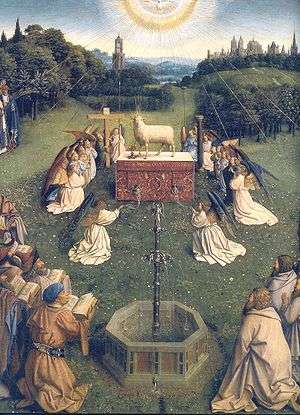
Lamb of God (Greek: Ἀμνὸς τοῦ Θεοῦ, Amnos tou Theou; Latin: Agnus Dei) is a title for Jesus that appears in the Gospel of John. It appears at John 1:29, where John the Baptist sees Jesus and exclaims, "Behold the Lamb of God who takes away the sin of the world."[1]
Christian doctrine holds that divine Jesus chose to suffer crucifixion at Calvary as a sign of his full obedience to the will of his divine Father, as an "agent and servant of God".[2][3] The Christian concept of a Lamb of God is based very loosely on the Jewish Korban Pesach, which has nothing to do with human sacrifice nor with sin in any way. In Christian theology the Lamb of God is viewed as foundational and integral to the message of Christianity.[4][5]
A lion-like lamb that rises to deliver victory after being slain appears several times in the Book of Revelation.[6] It is also referred to in Pauline writings, 1 Corinthians 5:7 suggests that Saint Paul intends to refer to the death of Jesus, who is the Paschal Lamb, using the theme found in Johannine writings.[7] The lamb metaphor is also in line with Psalm 23, which depicts God as a shepherd leading his flock (mankind).
The Lamb of God title is widely used in Christian prayers, and the Agnus Dei is used as a standard part of the Catholic Mass, as well as the classical Western Liturgies of the Anglican and Lutheran Churches. It also is used in liturgy and as a form of contemplative prayer.[8][9] The Agnus Dei also forms a part of the musical setting for the Mass.
As a visual motif the lamb has been most often represented since the Middle Ages as a standing haloed lamb with a foreleg cocked "holding" a pennant with a red cross on a white ground, though many other ways of representing it have been used.
Gospel of John
The title Lamb of God for Jesus appears in the Gospel of John, with the initial proclamation: "Behold the Lamb of God who takes away the sin of the world" in John 1:29, the title reaffirmed the next day in John 1:36.[1] The second use of the title Lamb of God takes place in the presence of the first two apostles of Jesus, who immediately follow him, address him as Rabbi with respect and later in the narrative bring others to meet him.[10]
These two proclamations of Jesus as the Lamb of God closely bracket the Baptist's other proclamation in John 1:34: "I have borne witness that this is the Son of God". From a Christological perspective, these proclamations and the descent of the Holy Spirit as a dove in John 1:32 reinforce each other to establish the divine element of the Person of Christ.[1] In Johannine Christology the proclamation "who takes away the sin of the world" begins the unfolding of the salvific theme of the redemptive and sacrificial death of Jesus followed by his resurrection which is built upon in other proclamations such as "this is indeed the Saviour of the world" uttered by the Samaritans in John 4:42.[11][12]
Book of Revelation
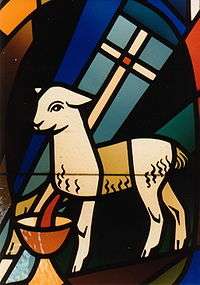
The Book of Revelation includes over twenty-nine references to a lion-like lamb ("slain but standing") which delivers victory in a manner reminiscent of the resurrected Christ.[6] In the first appearance of the lamb in Revelation (5:1-7) only the lamb (which is of the tribe of Judah, and the root of David) is found worthy to take the judgment scroll from God and break the seals.[6] The reference to the lamb in Revelation 5:6 relates it to the Seven Spirits of God which first appear in Revelation 1:4 and are associated with Jesus who holds them along with seven stars.[13]
In Revelation 21:14 the lamb is said to have twelve apostles.[6] The handing of the scroll (i.e. the book containing the names of those who will be saved) to the risen lamb signifies the change in the role of the lamb. In Calvary, the lamb submitted to the will of the Father to be slain, but now is trusted with the judgment of mankind.[14]
From the outset, the book of Revelation is presented as a "revelation of Jesus Christ" and hence the focus on the lamb as both redeemer and judge presents the dual role of Jesus: he redeems man through self-sacrifice, yet calls man to account on the day of judgment.[15]
Christology
The concept of the Lamb of God fits well within John's "agent Christology", in which sacrifice is made as an agent of God or servant of God for the sake of eventual victory.[3][16]
The theme of a sacrificial lamb which rises in victory as the Resurrected Christ was employed in early Christology, e.g. in 375 Saint Augustine wrote: "Why a lamb in his passion? Because he underwent death without being guilty of any iniquity. Why a lion in his passion? Because in being slain, he slew death. Why a lamb in his resurrection? Because his innocence is everlasting. Why a lion in his resurrection? Because everlasting also is his might."[17]
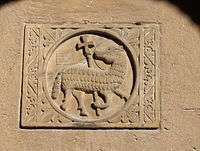
The 11th century Christology of Saint Anselm of Canterbury specifically disassociates Lamb of God from the Old Testament concept of a scapegoat which is subjected to punishment for the sins of others, without knowing it or willing it.[2] Anselm emphasized that as Lamb of God, Jesus chose to suffer in Calvary as a sign of his full obedience to the will of the Father.[2]
John Calvin presented the same Christological view of "The Lamb as the agent of God" by arguing that in his trial before Pilate and while at Herod's Court Jesus could have argued for his innocence, but instead remained mostly quiet and submitted to Crucifixion in obedience to the Father, for he knew his role as the Lamb of God.[18][19]
In modern Eastern Orthodox Christology, Sergei Bulgakov argued that the role of Jesus as the Lamb of God was "pre-eternally" determined by the Father before the creation of the world, as a sign of love by considering the scenario that it would be necessary to send The Son as an agent to redeem humanity disgraced by the fall of Adam.[20]

Multiple hypotheses about the suitable symbolism for the Lamb of God have been offered, within various Christological frameworks, ranging from the interpretation of Old Testament references to those of the Book of Revelation.[21] One view suggests the symbolism of Leviticus 16 as scapegoat, coupled with Romans 3:21-25 for atonement, while another view draws parallels with the Paschal Lamb in Exodus 12:1-4, coupled with John 1:29-36, and yet another symbolism relies on Revelation 5:5-14 in which the lamb is viewed as a lion who destroys evil.[21][22] However, as above Saint Anselm and John Calvin's view reject the Scapegoat symbolism for they view Jesus as making a knowing sacrifice as an agent of God, unlike an unwitting Scapegoat.[2][18][19]
In modern Roman Catholic Christology, Karl Rahner has continued to elaborate on the analogy that the blood of the Lamb of God, and the water flowing from the side of Christ on Calvary had a cleansing nature, similar to baptismal water. In this analogy, the blood of the Lamb washed away the sins of humanity in a new baptism, redeeming it from the fall of Adam.[23]
Liturgy and music
In the Mass of the Roman Rite and also in the Eucharist of the Anglican Communion, the Lutheran Church, and the Western Rite of the Orthodox Church the Agnus Dei is the invocation to the Lamb of God sung or recited during the fraction of the Host.[24] It is said to have been introduced into the Mass by Pope Sergius I (687–701).[25]
Agnus Dei has been set to music by many composers, usually as part of a Mass setting.[26][27]
Art

In Christian iconography, an Agnus Dei is a visual representation of Jesus as a lamb, since the Middle Ages, usually holding a standard or banner with a cross. This normally rests on the lamb's shoulder and is held in its right foreleg. Often the cross will have a white banner suspended from it charged with a red cross (similar to St George's Cross), though the cross may also be rendered in different colors. Sometimes the lamb is shown lying atop a book with seven seals hanging from it. This is a reference to the imagery in the Book of Revelation 5:1-13, ff. Occasionally, the lamb may be depicted bleeding from the area of the heart (Cf. Revelation 5:6), symbolizing Jesus' shedding of his blood to take away the sins of the world (Cf. John 1:29, 1:36).
In Early Christian art the symbol appears very early on. Several mosaics in churches include it, some showing a row of twelve sheep representing the apostles flanking the central Agnus Dei, as in Santi Cosma e Damiano, Rome (526-30).
The Moravian Church uses an Agnus Dei as their seal with the surrounding inscription Vicit agnus noster, eum sequamur ("Our Lamb has conquered, let us follow him").
Although the depiction of Jesus as the Lamb of God is of ancient origin, it is not used in the liturgical iconography of the Eastern Orthodox Church. The reason for this is that the depictions of Jesus in the Orthodox Church are anthropomorphic rather than symbolic, as a confession of the Orthodox belief in the Incarnation of the Logos. However, there is no objection to the application of the term "Lamb of God" to Jesus. In fact, the Host used in the Orthodox Divine Liturgy is referred to as the Lamb (Greek: άμνος, amnos; Slavonic: Агнецъ, agnets).
Heraldry
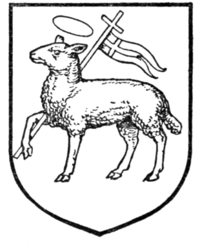
A Paschal Lamb is a charge used in heraldry, for example as the crest of the Davie Baronets, and is blazoned: A paschal lamb[28] This charge is depicted as a lamb standing with body facing towards the dexter (viewer's left), with nimbus, and with head facing forwards (or turned looking backwards to sinister, termed reguardant) holding under its right foreleg a flagpole, tipped with a small cross, resting at a diagonal angle over its shoulder, flying a banner of the Cross of St. George (except in Perth's coat of arms, where it flies a banner of the Cross of St Andrew).
| Wikimedia Commons has media related to Paschal lamb in heraldry. |
Catholic sacramental
In the Roman Catholic Church, an Agnus Dei is a disc of wax, stamped with an image of Jesus as a lamb bearing a cross, that is blessed by the Pope as a sacramental.[29] These were often set in jewelry, and might be worn round the neck on a chain, or as a brooch.
Gallery
 The Coat of arms of Puerto Rico features the Lamb of God and other symbols including the Kingdom of Jerusalem Cross and the Catholic Monarchs initials.
The Coat of arms of Puerto Rico features the Lamb of God and other symbols including the Kingdom of Jerusalem Cross and the Catholic Monarchs initials.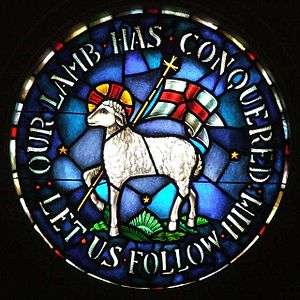
 Brass Agnus Dei from altar-front in the Cathedral of the Assumption in Louisville, Kentucky.
Brass Agnus Dei from altar-front in the Cathedral of the Assumption in Louisville, Kentucky.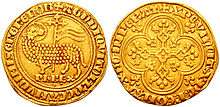 Agnus Dei on the 1311 coin of King Philip IV of France.
Agnus Dei on the 1311 coin of King Philip IV of France.- Eucharistic Pall, embroidered with the Agnus Dei reposing on the book of the Seven Seals.

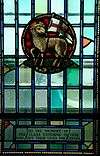 Stained glass Lamb of God carrying the vexillum, Royal Military College of Canada
Stained glass Lamb of God carrying the vexillum, Royal Military College of Canada Modern copy of a Romanesque Agnus Dei, Santiago de Compostela, Galicia
Modern copy of a Romanesque Agnus Dei, Santiago de Compostela, Galicia The Agnus Dei on Perth, Scotland's coat of arms holds the Scottish flag.
The Agnus Dei on Perth, Scotland's coat of arms holds the Scottish flag.
See also
References
- 1 2 3 The Lamb of God by Sergei Bulgakov 2008 ISBN 0-8028-2779-9 page 263
- 1 2 3 4 The Christology of Anselm of Canterbury by Dániel Deme 2004 ISBN 0-7546-3779-4 pages 199-200
- 1 2 The Christology of the New Testament by Oscar Cullmann 1959 ISBN 0-664-24351-7 page 79
- ↑ Karl Gerlach (1998). The Antenicene Pascha: A Rhetorical History. Peeters Publishers. p. 21.
Long before this controversy, Ex 12 as a story of origins and its ritual expression had been firmly fixed in the Christian imagination. Though before the final decades of the second century only accessible as an exegetical tradition, already in the Paulin letters the Exodus saga is deeply involved with the celebration of bath and meal. Even here, this relationship does not suddenly appear, but represents developments in ritual narrative that mus have begun at the very inception of the Christian message. Jesus of Nazareth was crucifed during Pesach-Mazzot, an event that a new covenant people of Jews and Gentiles both saw as definitive and defining. Ex 12 is thus one of the few reliable guides for tracing the synergism among ritual, text, and kerygma before the Council of Nicaea.
- ↑ Matthias Reinhard Hoffmann (2005). The Destroyer and the Lamb: The Relationship Between Angelomorphic and Lamb Christology in the Book of Revelation. Mohr Siebeck. p. 117. ISBN 3-16-148778-8.
1.2.2. Christ as the Passover Lamb from Exodus A number of features throughout Revelation seem to correspond to Exodus 12: The connection of Lamb and Passover, a salvific effect of the Lamb's blood and the punishment of God's (and His people's) opponents from Exodus 12 may possibly be reflected within the settings of the Apocalypse. The concept of Christ as a Passover lamb is generally not unknown in NT or early Christian literature, as can for instance be seen in 1 Corinthians 5:7, 1 Peter 1:19 or Justin Martyr's writing (Dial. 111:3). In the Gospel of John, especially, this connection between Christ and Passover is made very explicit.
- 1 2 3 4 Reclaiming the book of Revelation: by Wilfried E. Glabach 2007 ISBN 1-4331-0054-1 pages
- ↑ http://www.newadvent.org/fathers/220115.htm
- ↑ Holy Conversation: Spirituality for Worship by Jonathan Linman 2010 ISBN 0-8006-2130-1 page 148
- ↑ Prayer Book Parallels: The Public Services of the Church by Paul Victor Marshall 1990 ISBN 0-89869-181-8 page 369
- ↑ The Life and Ministry of Jesus by Douglas Redford 2007 ISBN 0-7847-1900-4 pages 100-101
- ↑ Johannine Christology and the Early Church by T. E. Pollard 2005 ISBN 0-521-01868-4 page 21
- ↑ Studies in Early Christology by Martin Hengel 2004 ISBN 0-567-04280-4 page 371
- ↑ New Testament Theology by Thomas R. Schreiner 2008 Baker Academic ISBN 0-8010-2680-6 page 502
- ↑ Studies in Revelation by M. R. De Haan, Martin Ralph DeHaan 1998 ISBN 0-8254-2485-2 page 103
- ↑ Revelation by Ben Witherington ISBN 978-0-521-00068-0 page 27
- ↑ The Johannine exegesis of God by Daniel Rathnakara Sadananda 2005 ISBN 3-11-018248-3 page 281
- ↑ Revelation by William C. Weinrich 2005 ISBN 0-8308-1497-3 page 73
- 1 2 The Reading and Preaching of the Scriptures by Hughes Oliphant Old 2002 ISBN 0-8028-4775-7 page 125
- 1 2 Calvin's Christology by Stephen Edmondson 2004 ISBN 0-521-54154-9 page 91
- ↑ The Lamb of God by Sergei Bulgakov 2008 ISBN 0-8028-2779-9 page 129
- 1 2 Symbols of Jesus: A Christology of Symbolic Engagement by Robert C. Neville (Feb 4, 2002) Cambridge Univ Pres ISBN 0521003539 page 13
- ↑ The Lion and the Lamb by Andreas J. Kostenberger, L. Scott Kellum and Charles L Quarles (Jul 15, 2012) ISBN 1433677083 page 114
- ↑ Encyclopedia of theology: a concise Sacramentum mundi by Karl Rahner 2004 ISBN 0-86012-006-6 page 74
- ↑ See "Agnus Dei (in Liturgy)" article from The Catholic Encyclopedia
- ↑ Lives of Orthodox Western Saints by Reader Daniel Lieuwen (St Nicholas Orthodox Church, McKinney TX)
- ↑ The Harvard dictionary of music by Don Michael Randel 2003 ISBN 0-674-01163-5 page 28
- ↑ The earliest settings of the Agnus Dei and its tropes by Charles Mercer Atkinson, University of North Carolina at Chapel Hill 1975 page 14
- ↑ Montague-Smith, P.W. (ed.), Debrett's Peerage, Baronetage, Knightage and Companionage, Kelly's Directories Ltd, Kingston-upon-Thames, 1968, p.232
- ↑ "Agnus Dei" article from The Catholic Encyclopedia
External links
-
 Media related to Agnus Dei at Wikimedia Commons
Media related to Agnus Dei at Wikimedia Commons